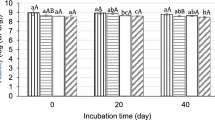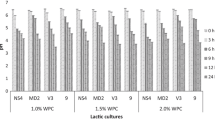Abstract
With increasing application of yeast in fermented milk, in order to study the effect of yeast on milk protein during the fermentation process, the effects of the presence of Kluyveromyces marxianus in milk fermented by Streptococcus thermophilus and Lactobacillus bulgaricus were investigated. After fermentation, the amino acid, protein, and peptide contents were analyzed by ultra-performance liquid chromatography, two-dimensional gel electrophoresis, and liquid chromatography–mass spectrometry, respectively. After the addition of K. marxianus for fermentation, 25 protein spots changed significantly. These were mostly caseins and bovine serum proteins, and the content of total free amino acids increased by 16.30%; ten types of bioactive peptides were identified. Furthermore, the number of peptide types in milk fermented by K. marxianus increased significantly compared with milk fermented by Lactobacillus. K. marxianus is considered to promote proteometabolism in milk when added with Lactobacillus, generate flavor compounds, and improve the digestion and absorption character of milk.


Similar content being viewed by others
References
Shihata A, Shah NP. Proteolytic profiles of yogurt and probiotic bacteria. Int. Dairy J. 10: 401–408 (2000)
Shi J, Luo YK, Xiao Y, Li Z, Xu Q, Yao MJ. Effects of fermentation by Lactobacillus casei on the antigenicity and allergenicity of four bovine milk proteins. Int. Dairy J. 35: 75–80 (2014)
Lourens-Hattingh A, Viljoen B. Growth and survival of a probiotic yeast in dairy products. Food Res. Int. 34(9): 791–796 (2001)
De Freitas I, Pinon N, Maubois JL, Lortal S, Thierry A. The addition of a cocktail of yeast species to Cantalet cheese changes bacterial survival and enhances aroma compound formation. Int. J. Food Microbiol. 129(1): 37–42 (2009)
Klein N, Zourari A, Lortal S. Peptidase activity of four yeast species frequently encountered in dairy products-comparison with several dairy bacteria. Int. Dairy J. 12(10): 853–861 (2002)
Grba S, Stehlik-Tomas V, Stanzer D, Vahcic N, Skrlin A. Selection of yeast strain Kluyveromyces marxianus for alcohol and biomass production on whey. Chem. Biochem. Eng. Q. 16(1): 13–16 (2002)
Zafar S, Owais M. Ethanol production from crude whey by Kluyveromyces marxianus. Biochem. Eng. J. 27(3): 295–298 (2006)
Narvhusa JA, Gadaga TH. The role of interaction between yeasts and lactic acid bacteria in African fermented milks: a review. Int. J. Food Microbiol. 86: 51–60 (2003)
Wang SY, Chen HC, Liu JR, Lin YC, Chen MJ. Identification of yeasts and evaluation of their distribution in Taiwanese kefir and viili starters. J. Dairy Sci. 91(10): 3798–3805 (2008)
Elfahri KR, Vasiljevic T, Yeager T, Donkor ON. Anti-colon cancer and antioxidant activities of bovine skim milk fermented by selected Lactobacillus helveticus strains. J. Dairy Sci. 99(1): 31–40 (2016)
Hafeez Z, Cakir-Kiefer C, Roux E, Perrin C, Miclo L, Dary-Mourot A. Strategies of producing bioactive peptides from milk proteins to functionalize fermented milk products. Food Res. Int. 63 (part A): 71–80 (2014)
Simova E, Beshkova D, Angelov A, Hristozova T, Frengova G, Spasov Z. Lactic acid bacteria and yeasts in kefir grains and kefir made from them. J. Ind. Microbiol. Biot. 28(1): 1–6 (2002)
Roostita R, Fleet GH. Growth of yeasts in milk and associated changes to milk composition. Int. J. Food Microbiol. 31: 205–219 (1996)
Holland JW, Gupta R, Deeth HC, Alewood PF. UHT milk contains multiple forms of αS1-casein that undergo degradative changes during storage. Food Chem. 133(3): 689–696 (2012)
Roucher VF, Desnots E, Naël C, Agnoux AM, Alexandre-Gouabau MC, Darmaun D, Boquien CY. Use of UPLC-ESI-MS/MS to quantitate free amino acid concentrations in micro-samples of mammalian milk. SpringerPlus. 2(1): 622 (2013)
Goncalves A, Poeta P, Monteiro R, Marinho C, Silva N, Guerra A, Petrucci-Fonseca F, Rodrigues J, Torres C, Vitorino R, Domingues P, Igrejas G. Comparative proteomics of an extended spectrum β-lactamase producing Escherichia coli strain from the Iberian wolf. J. Proteomics. 104: 80–93 (2014)
Mamone G, Caira S, Garro G, Nicolai A, Ferranti P, Picariello G, Malorni A, Chianese L, Addeo F. Casein phosphoproteome: Identification of phosphoproteins by combined mass spectrometry and two-dimensional gel electrophoresis. Electrophoresis. 24(16): 2824–2837 (2003)
Holder A, Thienel K, Klaiber I, Pfannstiel J, Weiss J, Hinrichs J. Quantification of bio-and techno-functional peptides in tryptic bovine micellar casein and β-casein hydrolysates. Food Chem. 158: 118–124 (2014)
Jrad Z, Hatmi HE, Adt I, Girardet JM, Cakir-Kiefer C, Jardin J, Degraeve P, Khorchani T. Oulahal N. Effect of digestive enzymes on antimicrobial, radical scavenging and angiotensin I-converting enzyme inhibitory activities of camel colostrum and milk proteins. Dairy Sci. Technol. 94(3): 205–224 (2014)
Mei J, Guo Q, Wu Y, Li Y, Yu H. Study of proteolysis, lipolysis, and volatile compounds of a Camembert-type cheese manufactured using a freeze-dried Tibetan kefir co-culture during ripening. Food Sci. Biotechnol. 24(2): 393–402 (2015)
Gadaga TH, Mutukumira AN, Narvhus JA. The growth and interaction of yeasts and lactic acid bacteria isolated from Zimbabwean naturally fermented milk in UHT milk. Int. J. Food Microbiol. 68(1): 21–32 (2001)
Akabanda F, Owusu-Kwarteng J, Tano-Debrah K, Glover RLK, Nielsen DS, Jespersen L. Taxonomic and molecular characterization of lactic acid bacteria and yeasts in nunu, a Ghanaian fermented milk product. Food Microbiol. 34: 277–283 (2013)
Kunji ERS, Mierau I, Hagting A, Poolman B, Konings WN. The proteotytic systems of lactic acid bacteria. Antonie van Leeuwenhoek. 70(2–4): 187–221 (1996)
Zhang DD, Chen LJ, Zhang M, Zhang Y, Fang GZ, Jiang TM. Improved peptide generation from milk fermented by heat-shocked Lactobacillus helveticus. Int. J. Food Sci. Tech. 52(2): 366–373 (2017)
Xie M, Shevchenko A, Wang B, Shevchenko A, Wang C, Yang Y. Identification of a dairy product in the grass woven basket from Gumugou Cemetery (3800 BP, northwestern China). Quatern. Int. doi:10.1016/j.quaint.2016.04.015 (2016)
Bujacz A, Zielinski K, Sekula B. Structural studies of bovine, equine, and leporine serum albumin complexes with naproxen. Proteins 82(9): 2199–2208 (2014)
Davies NM, Anderson KE. Clinical pharmacokinetics of naproxen. Clin. Pharmacokinet. 32: 268–293 (1997)
Otte J, Lenhard T, Flambard B, Sørensen KI. Influence of fermentation temperature and autolysis on ACE-inhibitory activity and peptide profiles of milk fermented by selected strains of Lactobacillus helveticus and Lactococcus lactis. Int. Dairy J. 21(4): 229–238 (2011)
Robert MC, Razaname A, Mutter M, Juillerat MA. Identification of angiotensin-I-converting enzyme inhibitory peptides derived from sodium caseinate hydrolysates produced by Lactobacillus helveticus NCC 2765. J. Agr. Food Chem. 52(23): 6923–6931 (2004)
Chang OK, Roux É, Awussi AA, Miclo L, Jardin J, Jameh N, Dary A, Humbert G, Perrin C. Use of a free form of the Streptococcus thermophilus cell envelope protease PrtS as a tool to produce bioactive peptides. Int. Dairy J. 38(2): 104–115 (2014)
Hayes M, Stanton C, Slattery H, O’Sullivan O, Hill C, Fitzgerald G, Ross R. Casein fermentate of Lactobacillus animalis DPC6134 contains a range of novel propeptide angiotensin-converting enzyme inhibitors. Appl. Environ. Microb. 73(14): 4658–4667 (2007)
Ong L, Henriksson A, Shah NP. Angiotensin converting enzyme-inhibitory activity in Cheddar cheeses made with the addition of probiotic Lactobacillus casei sp. Dairy Sci. Technol. 87(2): 149–165 (2007)
Hernández-Ledesma B, Miralles B, Amigo L, Ramos M, Recio I. Identification of antioxidant and ACE-inhibitory peptides in fermented milk. J. Sci. Food Agr. 85(6): 1041–1048 (2005)
Yamamoto N, Akino A, Takano T. Antihypertensive effect of the peptides derived from casein by an extracellular proteinase from Lactobacillus helveticus CP790. J. Dairy Sci. 77(4): 917–922 (1994)
Sandré C, Gleizes A, Forestier F, Gorges-Kergot R, Chilmonczyk S, Léonil J, Moreau MC, Labarre C. A peptide derived from bovine β-casein modulates functional properties of bone marrow-derived macrophages from germfree and human flora-associated mice. J. Nutr. 131(11): 2936–2942 (2001)
Birkemo GA, O’Sullivan O, Ross RP, Hill C. Antimicrobial activity of two peptides casecidin 15 and 17, found naturally in bovine colostrum. J. Appl. Microbiol. 106(1): 233–240 (2009)
Minkiewicz P, Slangen CJ, Dziuba J, Visser S, Mioduszewska H. Identification of peptides obtained via hydrolysis of bovine casein by chymosin using HPLC and mass spectrometry. Milchwissenschaft. 55(1): 14–17 (2000)
Silva SV, Pihlanto A, Malcata FX. Bioactive peptides in ovine and caprine cheese like systems prepared with proteases from Cynara cardunculus. J. Dairy Sci. 89(9): 3336–3344 (2006)
Somkuti GA, Paul M. Enzymatic fragmentation of the antimicrobial peptides casocidin and isracidin by Streptococcus thermophilus and Lactobacillus delbrueckii ssp. bulgaricus. Appl. Microbiol. Biot. 87(1): 235–242 (2010)
Acknowledgements
The authors gratefully acknowledge project support from the National Science & Technology Pillar Program during the Twelfth Five-year Plan Period, China (2013BAD18B04) and the Science and Technology Program of Beijing, China (D141100004814001).
Author information
Authors and Affiliations
Corresponding author
Ethics declarations
Conflict of interest
The authors declare no conflict of interest.
Rights and permissions
About this article
Cite this article
Zhang, DD., Liu, JL., Jiang, TM. et al. Influence of Kluyveromyces marxianus on proteins, peptides, and amino acids in Lactobacillus-fermented milk. Food Sci Biotechnol 26, 739–748 (2017). https://doi.org/10.1007/s10068-017-0094-2
Received:
Revised:
Accepted:
Published:
Issue Date:
DOI: https://doi.org/10.1007/s10068-017-0094-2




